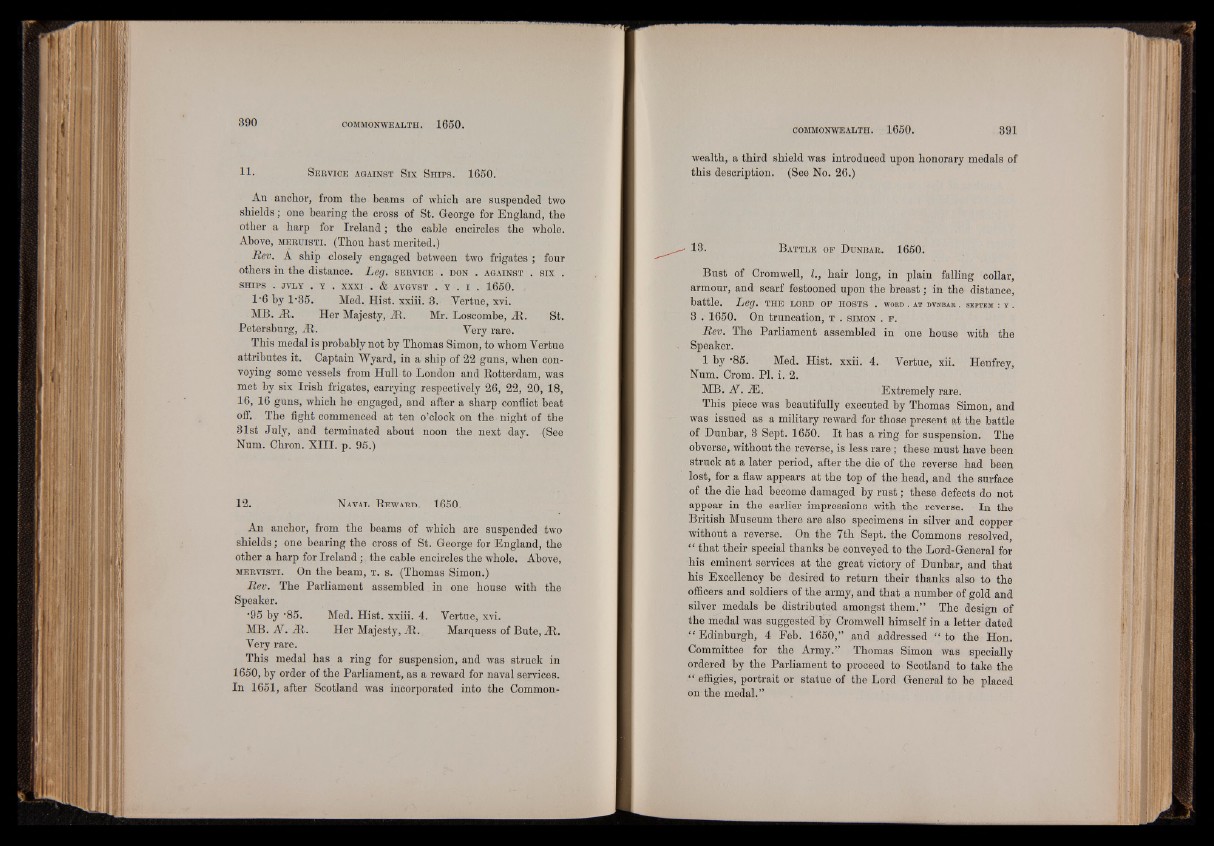
11. S e r v ic e ag a in st S ix S h i p s . 1650.
An anchor, from the heams of which are suspended two
shields; one bearing the cross of St. George for England, the
other a harp for Ireland; the cable encircles the whole.
Above, m e r u is t i . (Thou hast merited.)
Rev. A ship closely engaged between two frigates ; four
others in the distance. Leg. s e r v ic e . don . ag a in st . six .
SHIPS . JVLY . Y . XXXI . & AVGVST . Y . I . 1650. ,
1‘6 by 1'35. Med. Hist, xxiii. 3. Vertue, xvi.
MB. JR. Her Majesty, JR. Mr. Loscombe, At. St.
Petersburg, JR. Very rare.
This medal is probably not by Thomas Simon, to whom Vertue
attributes it. Captain Wyard, in a ship of 22 guns, when con-
voying some vessels from Hull to London and Rotterdam, was
met by six Irish frigates, carrying respectively 26, 22, 20, 18,
16, 16 guns, which he engaged, and after a sharp conflict beat
off. The fight commenced at ten o’clock on the night of the
31st July, and terminated about noon the next day. (See
Num. Chron. XIII. p. 95.)
12. N aval R ew a r d . 1650.
An anchor, from the beams of which are suspended two
shields; one bearing the cross of St. George for England, the
other a harp for Ireland; the cable encircles the whole. Above,
m e r v is t i . On the beam, t . s . (Thomas Simon.)
Rev. The Parliament assembled in one house with the
Speaker.
•95 by ’85. Med. Hist, xxiii. 4. Vertue, xvi.
MB. M. JR. Her Majesty, JR. Marquess of Bute, JR.
Very rare.
This medal has a ring for suspension, and was struck in
1650, by order of the Parliament, as a reward for naval services.
In 1651, after Scotland was incorporated into the Commonwealth,
a third shield was introduced upon honorary medals of
this description. (See No. 26.)
13. B a t t l e o p D un ba r . 1650.
Bust of Cromwell, I., hair long, in plain falling collar,
armour, and scarf festooned upon the breast; in the distance,
battle. Leg. THE LORD OF HOSTS . WORD . AX d v n b a r . SEPT km : y .
3 . 1650. On truncation, t . simon . f .
Rev. The Parliament assembled in one house with the
Speaker.
1 by ’85. Med. Hist. xxii. 4. Vertue, xii. Heufrey,
Num. Crom. PI. i. 2.
MB. N . JE. Extremely rare.
This piece was beautifully executed by Thomas Simon, and
was issued as a military reward for those present at the battle
of Dunbar, 3 Sept. 1650. It has a ring for suspension. The
obverse, without the reverse, is less rare; these must have been
struck at a later period, after the die of the reverse had been
lost, for a flaw appears at the top of the head, and the surface
of the die had become damaged by ru s t; these defects do not
appear in the earlier impressions with the reverse. In the
British Museum there are also specimens in silver and copper
without a reverse. On the 7th Sept. the Commons resolved,
“ that their special thanks be conveyed to the Lord-General for
his eminent services at the great victory of Dunbar, and that
his Excellency be desired to return their thanks also to the
officers and soldiers of the army, and that a number of gold and
silver medals be distributed amongst them.” The design of
the medal was suggested by Cromwell himself in a letter dated
“ Edinburgh, 4 Feb. 1650,” and addressed “ to the Hon.
Committee for the Army.” Thomas Simon was specially
ordered by the Parliament to proceed to Scotland to take the
“ effigies, portrait or statue of the Lord General to be placed
on the medal.”